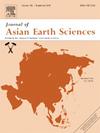Genesis and geochronology of the Bayanteeg Li-mineralized pegmatite in the Idermeg terrane, central Mongolia
IF 2.7
3区 地球科学
Q2 GEOSCIENCES, MULTIDISCIPLINARY
引用次数: 0
Abstract
We present the first petrographic, lithogeochemical, and geochronological study of the Bayanteeg LCT pegmatite located in Idermeg terrane, central Mongolia, and interpret the findings within the geodynamic setting. The pegmatite extends over 140 m with a width of 1.3 m and unknown depth within Neoproterozoic gneiss. The pegmatite contains plagioclase, quartz, and lepidolite with minor K-feldspar, spodumene, muscovite, and topaz, and accessory amounts of cassiterite, amblygonite, columbite-tantalite, monazite, zircon, apatite, and fluorite. Locally, minor secondary quartz and lepidolite occur interstitially between plagioclase and quartz and along the edges of primary lepidolite, respectively, implying late-stage hydrothermal influence. Lithogeochemical data show that the pegmatite contains 0.3–1.12 wt% Li, 256–1285 ppm Cs, and 59–522 ppm Ta. Monazite U-Th-Pb geochronology yielded an age of 144.9 ± 2.8 Ma while cassiterite yielded a U-Pb age of 134.8 ± 1.4 Ma. Lepidolite yielded 40Ar/39Ar plateau age of 131.25 ± 0.3 Ma. These age results fall during the geodynamic evolution of an intracontinental extension accompanied by the exhumation of metamorphic core complexes and extensive magmatism in the eastern Central Asian Orogenic Belt. These events occurred due to a combination of gravitational collapse resulting from lithospheric delamination and asthenospheric upwelling. The geodynamic setting during the pegmatite emplacement implies abnormally hot conditions, ruling out the possibility of anatectic origin. The pegmatite dike with elevated concentrations of Be, Ga, Rb, Nb, Sn, Cs, Ta, and Tl supports a granitic origin with a hidden parental granite at depth. The fact that the Idermeg terrane contains several LCT pegmatites implies an important exploration target for Li exploration.

蒙古中部伊德梅格地体巴彦特格锂矿化伟晶岩成因及年代学研究
本文首次对位于蒙古中部伊德梅格地体的Bayanteeg LCT伟晶岩进行了岩石学、岩石地球化学和年代学研究,并在地球动力学背景下解释了这些发现。伟晶岩在新元古代片麻岩中长140多米,宽1.3米,深度不详。伟晶岩含斜长石、石英、云母,少量钾长石、锂辉石、白云母、黄玉,少量锡石、闪长石、铌钽、独居石、锆石、磷灰石、萤石。局部次生石英和绢云母分别在斜长石和石英之间、原生绢云母边缘发育,暗示后期热液作用。岩石地球化学数据表明,伟晶岩中Li含量0.3 ~ 1.12 wt%, Cs含量256 ~ 1285 ppm, Ta含量59 ~ 522 ppm。独居石U-Th-Pb年代学结果为144.9±2.8 Ma,锡石U-Pb年代学结果为134.8±1.4 Ma。锂云母产40Ar/39Ar,平台年龄131.25±0.3 Ma。这些年龄结果落在中亚造山带东部变质岩心杂岩和广泛岩浆活动伴生的陆内伸展的地球动力学演化过程中。这些事件的发生是由于岩石圈剥离和软流圈上升流引起的重力坍缩的结合。伟晶岩侵位时的地球动力学背景表明异常炎热的环境,排除了析晶岩成因的可能性。Be、Ga、Rb、Nb、Sn、Cs、Ta、Tl含量较高的辉晶岩脉为花岗岩成因,深部有隐伏的母岩花岗岩。idemeg地体中含有多颗LCT伟晶岩,是重要的Li勘探目标。
本文章由计算机程序翻译,如有差异,请以英文原文为准。
求助全文
约1分钟内获得全文
求助全文
来源期刊

Journal of Asian Earth Sciences
地学-地球科学综合
CiteScore
5.90
自引率
10.00%
发文量
324
审稿时长
71 days
期刊介绍:
Journal of Asian Earth Sciences has an open access mirror journal Journal of Asian Earth Sciences: X, sharing the same aims and scope, editorial team, submission system and rigorous peer review.
The Journal of Asian Earth Sciences is an international interdisciplinary journal devoted to all aspects of research related to the solid Earth Sciences of Asia. The Journal publishes high quality, peer-reviewed scientific papers on the regional geology, tectonics, geochemistry and geophysics of Asia. It will be devoted primarily to research papers but short communications relating to new developments of broad interest, reviews and book reviews will also be included. Papers must have international appeal and should present work of more than local significance.
The scope includes deep processes of the Asian continent and its adjacent oceans; seismology and earthquakes; orogeny, magmatism, metamorphism and volcanism; growth, deformation and destruction of the Asian crust; crust-mantle interaction; evolution of life (early life, biostratigraphy, biogeography and mass-extinction); fluids, fluxes and reservoirs of mineral and energy resources; surface processes (weathering, erosion, transport and deposition of sediments) and resulting geomorphology; and the response of the Earth to global climate change as viewed within the Asian continent and surrounding oceans.
 求助内容:
求助内容: 应助结果提醒方式:
应助结果提醒方式:


